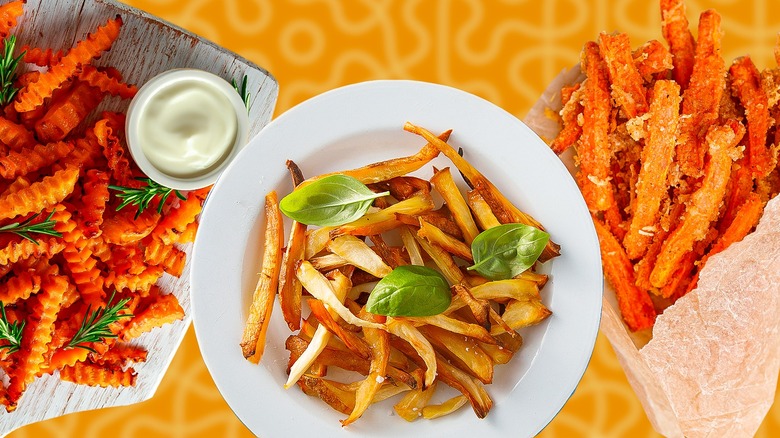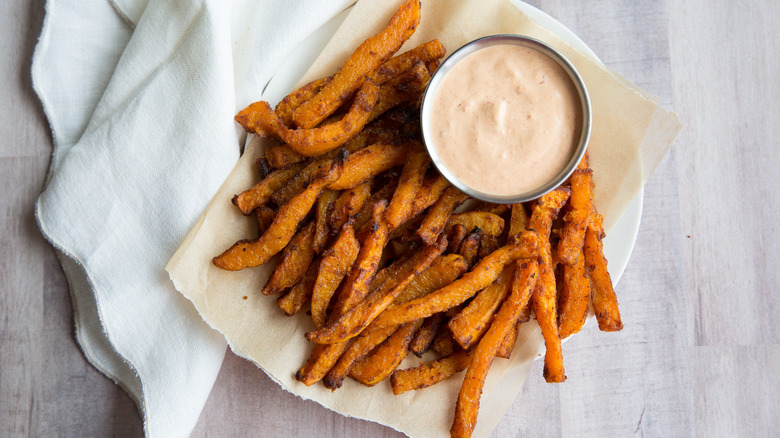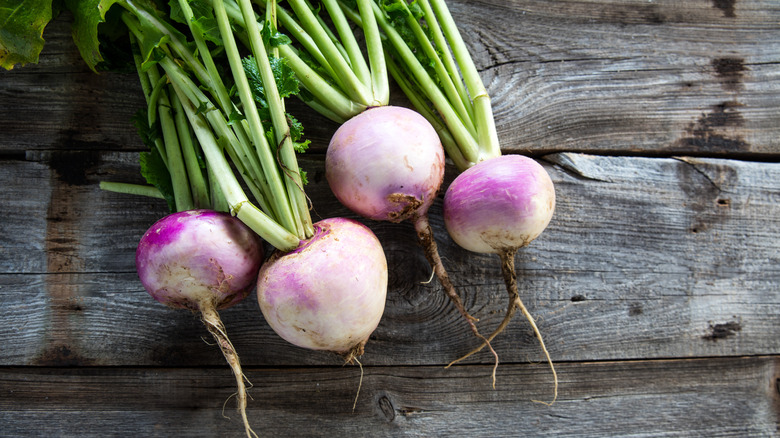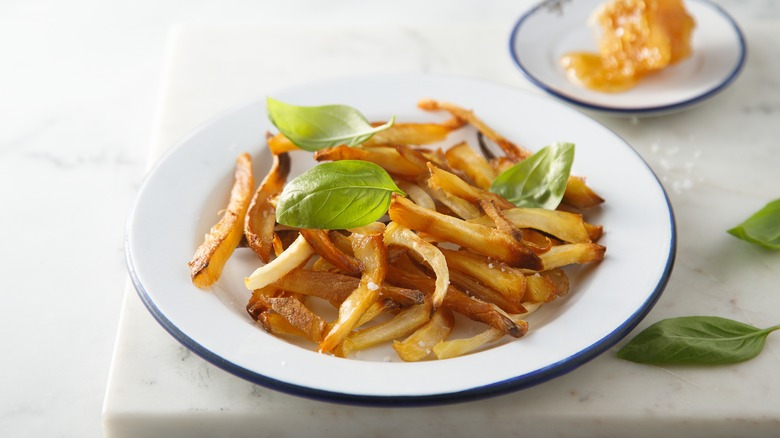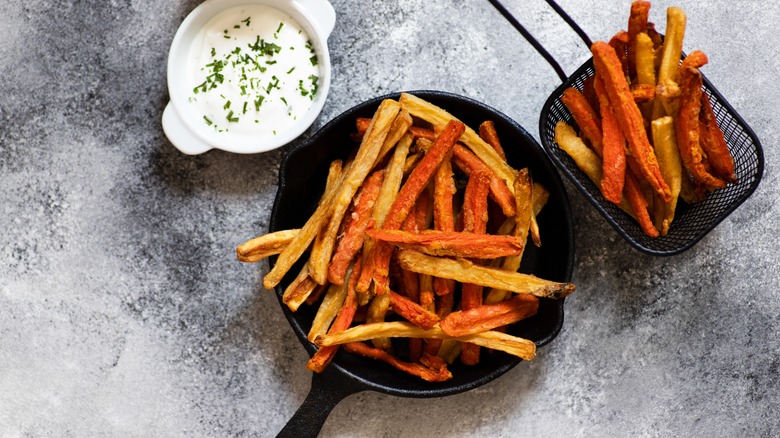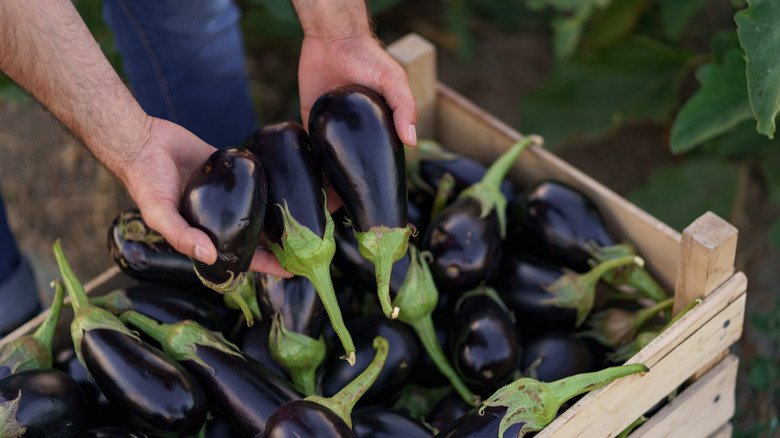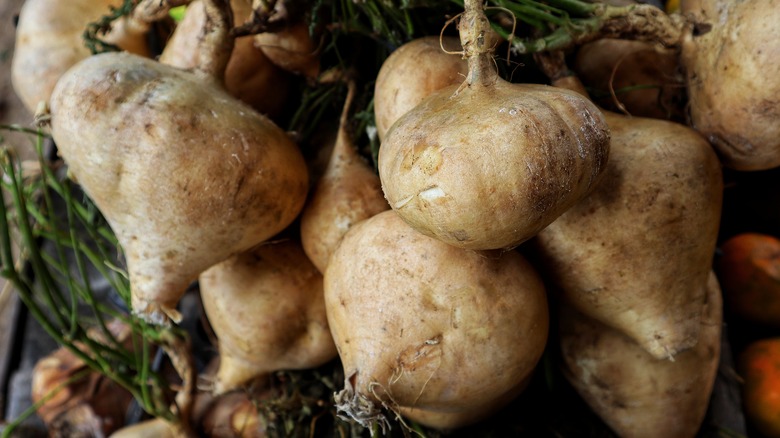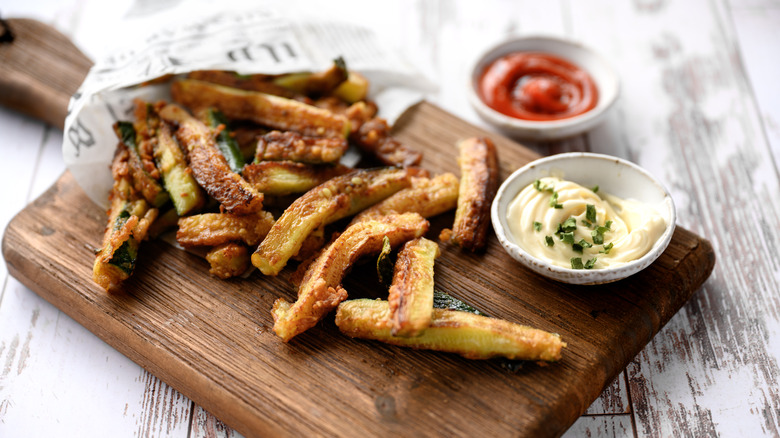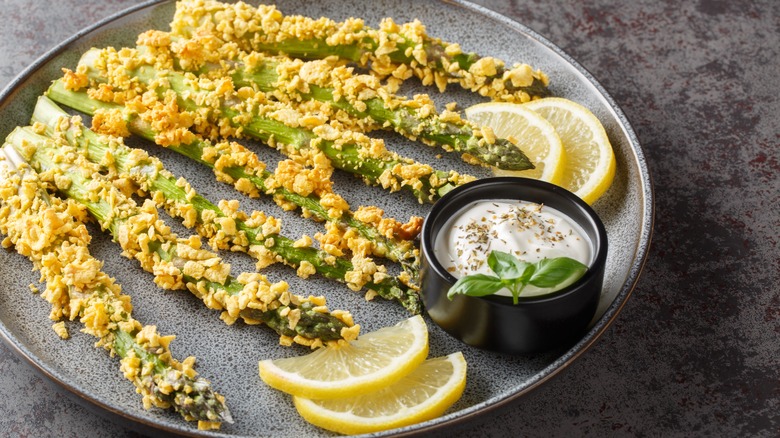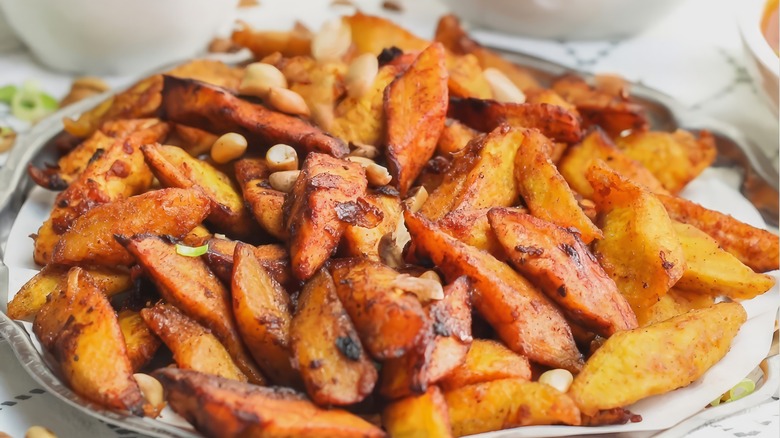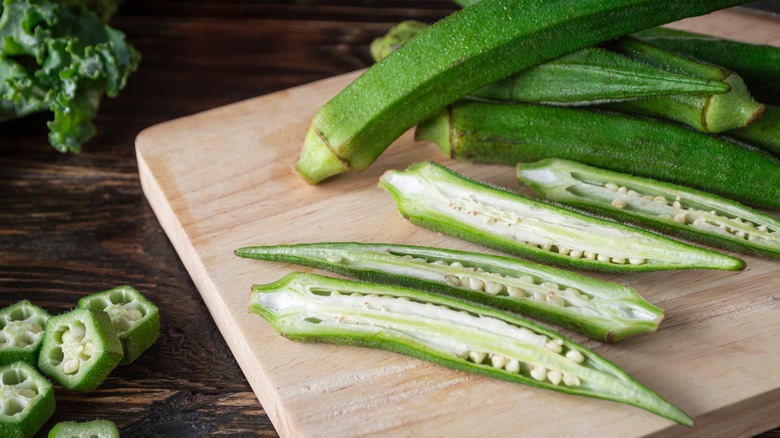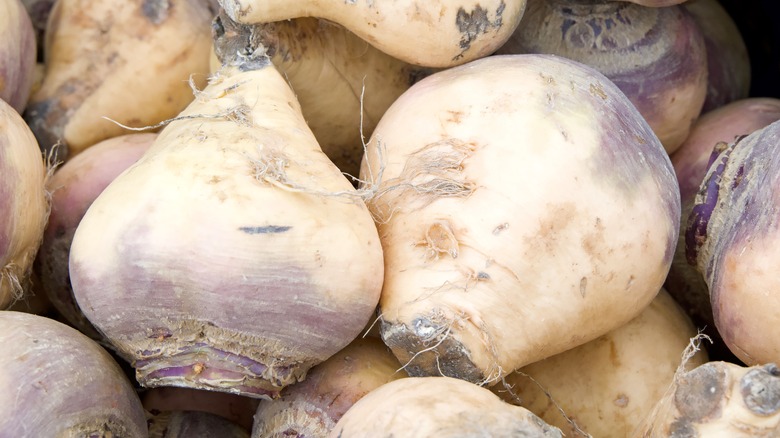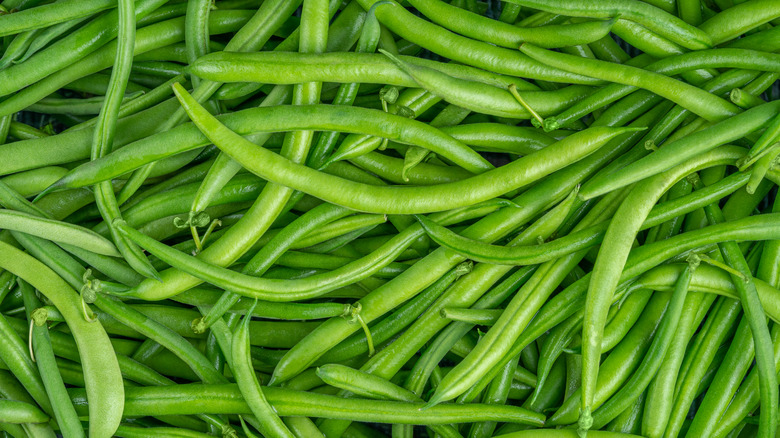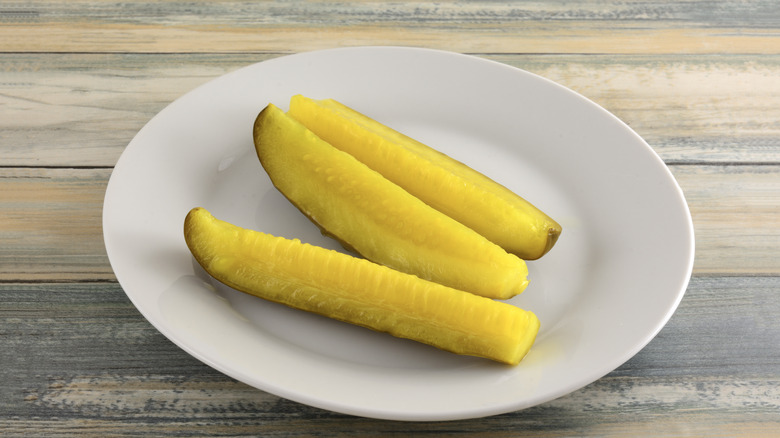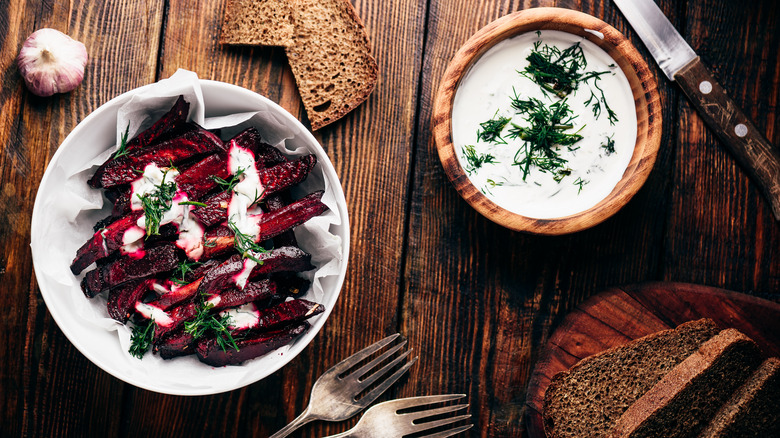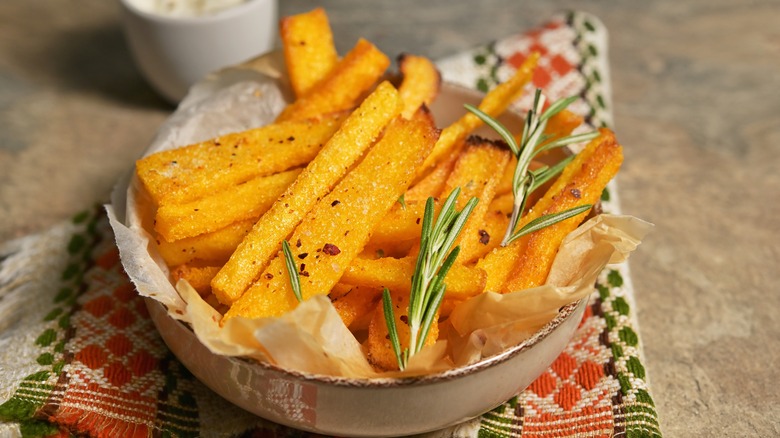18 Veggies For Making Delicious Fries That Aren't Potatoes
French fries are popular around the globe, and for good reason. Crispy, soft, starchy, salty, and warm, they're a real comfort food. Whether served at a casual fast food joint with a burger or at an elegant French restaurant with buttery mussels, french fried potatoes aren't going out of style any time soon.
That said, there's increasing interest in creating fries from vegetables that aren't potatoes (we're including both white and sweet potatoes in this definition). Whether it's for health reasons or simply for a love of vegetable variety, recipes for fries made from potato alternatives have been popping up everywhere. If there's a spice mixture you love to use with potato fries, you can use the same blend with your veggies or try some of these other ways season your fries. And don't forget flavorful dipping sauces to add extra zing to the dish! We know these fries don't taste like potatoes and the texture may be quite different, but trying some of these options is a great way to take advantage of the diverse flavors in the vegetable world while making fries that are still satisfying and delicious.
Butternut squash
Butternut squash is often roasted, which complements it's nutty and subtly sweet flavor, but there's another way to highlight this vegetable's delicious taste, and that's in fries. The inside of butternut squash is vivid orange, so it's easy to mistake fries made from butternut squash with sweet potato fries. The flavor is a little different though, so don't hesitate to branch out and try a new butternut squash fries recipe.
Most of the effort will be directed toward peeling the tough skin off the squash. This isn't the kind of recipe you can take a shortcut with, and cook the squash before peeling. You'll need it raw. However, there's a trick — microwave the squash for three minutes first to soften the skin and make peeling easier. Then, just cut the flesh into fry shapes as evenly as you can, season, and bake for about 35 minutes to crispy perfection.
Celeriac
Celeriac, also known as celery root, may not always be found in stores. When it is available, those unfamiliar with it may be hesitant to try it because — how can we put this? — it's not going to win any beauty awards. Celeriac is the brown, bulbous root of a kind of celery plant with a knotted and gnarled exterior surface, and its appearance is quite formidable. If you cut off the skin, however, you'll see that the inside has a smooth, firm texture and a color that resembles a turnip. The taste is earthy, with a hint of celery.
This is a great vegetable to try if you haven't had it before. It's often prepared roasted or mashed, but celeriac fries are another great option. They don't get as crispy as fries made from potatoes, but the tender interior and browned, slightly crispy exterior, along with the unique flavor, are distinctly tasty.
Turnips
Anyone who likes the flavor of turnips will love turnip fries, which may also be a bit better known than other kinds of alternative fries. The skin is edible so if the turnips aren't waxed and they look fresh and unblemished, you can leave them unpeeled, saving yourself some effort and making preparation easier. Some people prefer to peel them first, though, to give the fries a more uniform appearance.
Slice the turnips with a knife, into evenly-sized fry shapes before baking. Alternatively, you can use a vegetable spiralizer to make homemade curly fries. Turnip fries are delicious with just olive oil and salt, but like many of the vegetables on this list, they can be dressed up with more flavorful spices like cumin, paprika, and onion powder. You may enjoy a version crusted with Parmesan cheese and garlic powder, or a peppery version with black pepper and nutmeg.
Parsnips
You may be familiar with parsnips, root vegetables related to parsley that resemble white carrots. They have a texture similar to carrots, but their flavor is milder, earthy, slightly sweet, and is sometimes compared with licorice. The sweetest parsnips are the ones harvested after the first frost of the year. As an added bonus, parsnips are a healthy choice, as they're particularly high in vitamin C, vitamin K, fiber, and potassium.
With a firm, starchy texture that becomes tender when baked, parsnips are a good candidate for fries. Peel them before slicing them into fry shapes, or you can use a spiralizer if you like curly fries. You can keep it simple by tossing the fries with just olive oil and salt before baking, which is a good way to highlight the flavor of any vegetable you're making into fries. Otherwise, parsnip fries go particularly well with rosemary and garlic.
Carrots
Carrots are one of the easiest-to-find vegetables from this list. When roasted, they make a popular and flavorsome side dish, and crispy carrot fries are similarly sure to please. Carrots are nice and firm, hold their shape well during cooking, which also gives them a tender, creamy interior with a browned and crispy outside when baked.
After peeling the carrots, cut them into shape, either trying to make them all even and rectangular, or letting their carrot shape show. After seasoning, place them on a baking sheet in even rows, making sure that none of the pieces are touching, so they get crispier. Air frying carrots is another way to get crispy results. The secret, just like in the oven, is not letting them touch when placed in the basket. For a unique presentation, choose multicolored carrots. The white, orange, yellow, and purple fries will make a beautiful display.
Eggplant
While some veggie alternatives to potatoes make sense out of the box, especially firm ones like carrots or turnips, other fry contenders may leave you scratching your head. Eggplant is one of these, as it's normally prepared in ways that makes it very soft. Stay with us, though, because eggplant fries are definitely a thing, and they work.
You'll need to take a few steps to ensure the results are firm and crispy. Salt the eggplant fries after cutting them, let them sit in a colander for up to half an hour to release water, and pat them dry. Then bread them to help them get a crispy exterior. Dip the fries in egg and then coat them in cornmeal and breadcrumbs — or panko breadcrumbs, which we love because they're extra crispy. Deep frying probably gets these fries the crispiest, but if deep frying isn't for you, go ahead and bake them at 425 degrees Fahrenheit for up to 20 minutes, flipping halfway.
Jicama
Jicama is a starchy root vegetable native to Mexico and Central and South America. Its shape is similar to a turnip, it's starchy like a potato, and it's sometimes called a Mexican turnip or a Mexican potato (although it's actually a member of the bean family). Raw jicama is crunchy and juicy with a mild, slightly sweet taste that's sometimes compared to an apple or a water chestnut.
Jicama fries, like all the veggies on this list, don't taste like potato fries, but they're delicious just as they are. They stay sweet and juicy even when cooked, but they develop a browned and crispy exterior as a bonus. To savor jicama's unique flavor, just toss the fries with olive oil and salt. To add more flavor, try seasoning them with a mix of spices like chili powder, paprika, cumin, garlic powder, onion powder, cloves, and oregano. Serve with a squeeze of lime or chipotle dipping sauce.
Zucchini
Zucchini, like eggplant, is a vegetable that's normally served in a soft state and which may sound like a surprising choice for fries, but like eggplant fries, zucchini fries bake up crispy and irresistible. If you're avoiding potatoes or limiting carbs, zucchini is a low-carb and low-calorie solution that's also packed with vitamins and minerals.
The process for making zucchini fries is similar to the one for making eggplant fries, but it's quicker because zucchini doesn't need to be salted and sweated first. Just cut the zucchini into even fry shapes, dip the fries in egg, and then coat them in breadcrumbs mixed with salt and pepper. You can choose to add other flavorings to the breadcrumbs if you like, like Parmesan or garlic powder. Bake the fries at 425 degrees Fahrenheit for about 30 minutes. Finally, the mild flavor of zucchini is a good blank slate for experimenting to find which dipping sauces you like best with your fries.
Asparagus
The beauty of making fries from asparagus is that they're already shaped like fries, albeit round ones. All you need to do is snap off the lower ends and cut them in half if desired. Now, you can't pretend that these bright green fries look or taste anything like potatoes, which you can with fries made from pale, sturdy veggies like turnips (in the looks department, that is, not the taste department). All the same, we doubt you'll care after getting a taste of their crispy, caramelized goodness.
One way to make these fries is to coat very dry asparagus spears in flour, dip them in egg, and coat them in a panko breadcrumb mixture that includes Parmesan, salt, and pepper. Then just pop them in a 425 degree Fahrenheit oven for 10-15 minutes. You can also follow this air fryer asparagus fries recipe, in which the asparagus is dipped in aquafaba (canned chickpea liquid) instead of egg, for a vegan version.
Plantain
If you're familiar with Latin American tostones, round slices of plantain that are flattened and fried, you'll know how good fried plantains can taste and how satisfying their crispy, salty exterior is. They're excellent as fries for all the same reasons.
While you can choose green or yellow plantains for this, we recommend the green ones. These unripe plantains are starchier, have a milder flavor, and hold up better to cooking. You can get away with frying the yellow ones if you prefer a sweet taste, but they won't be as firm. To make plantain fries, peel and quarter a plantain, cut the quarters into thin strips, and salt them. Fry the strips on medium in oil for a few minutes per side until golden and crispy. If you prefer not to fry, you can bake the fries at 400 degrees Fahrenheit for about 20 minutes, flipping them halfway through.
Avocado
We know that putting the words avocado and fries together sounds like some kind of mistake, but just trust us on this one. Avocado slices are responsible for giving these fries a decadently creamy and warm interior, while the golden brown, textured, crispy exterior is thanks to a coating of panko breadcrumbs.
As you can see in this easy recipe for baked avocado fries, the secret to preparing them so they'll be easy to work with and hold their shape is using fruit that are slightly underripe. They should give just a tad when you press the top. Very ripe pieces will be too soft, while unripe ones will be too firm and flavorless. We know we're taking liberties with the definition of fries here, but semantics will be the last thing on your mind when you bite into these irresistibly crispy and creamy avocado fries. Try serving them with a cilantro-lime dipping sauce as a finishing touch.
Okra
We love the idea of turning green vegetables like okra into fries. For anyone eating low-carb or just trying to lighten up their meals, this combination gives you the satisfying fry experience you love while providing the health benefits that come from eating your greens.
Okra contains a slimy type of soluble fiber called mucilage, which may put some people off from eating it. Mucilage works well as a thickener for stews, but it's not so appreciated in fries. To reduce the slimy texture, try soaking the okra in vinegar for half an hour before preparing it. Then, cook the fries quickly at a high heat, since the effect of mucilage is enhanced with longer cooking times. That means deep frying is a good cooking method, but to keep them lighter, air frying, or baking at 400 degrees Fahrenheit are ideal for making a batch of deliciously crispy, unique okra fries.
Yuca
Yuca, a dark brown tuberous root with a white interior that is now grown in tropical areas around the globe, originated in the American tropics and is thought to have been first cultivated by the Maya in the Yucatán Peninsula. The plant is called cassava in English although it's frequently referred to by it's Spanish name, especially on the menus of Latin American restaurants that frequently serve it in the form of fries. By the way, don't confuse yuca with yucca, a tough desert plant with roots that are often used as soap.
A word of caution: Never eat raw yuca, because the plant contains a form of cyanide. Always remove the skin and cook the flesh well. To make yuca fries with a lovely crispy exterior and a tender, yet dense interior, you'll need to boil large pieces of peeled yuca first or the inside of the fries won't cook before the outside burns. Then thickly slice the pieces into fries and fry over medium heat until golden.
Rutabaga
Rutabagas may seem like little more than turnips' less attractive cousins, but don't pass over this humble root vegetable if you've never tried it. With an earthy flavor similar to a mild turnip or carrot, rutabagas can make excellent keto-friendly fries which look remarkably similar to potato fries, while having a much lower carb count. Some people even liken their flavor and texture to Yukon Gold potatoes. If you're already a big fan of rutabaga, we can guarantee you'll enjoy making these tasty root vegetables into fries, because they're simply delicious.
Peel and slice rutabagas into rectangular fry shapes, toss with oil and seasonings, and bake at 450 degrees Fahrenheit for about 15 minutes. If you're aiming for the crispiness of potato fries, toss them with a little cornstarch first to help them crisp up more. If you're worried about the carbs in cornstarch, substitute unflavored whey protein powder instead.
Green beans
If butternut squash fries are the most labor intensive because you need to remove the vegetable's tough peel, green beans may be the easiest because they are naturally the perfect length and width. If you find green beans kind of blah, make them more exciting with a Parmesan cheese and breadcrumb coating, which crisps up nicely in the oven. Another trick is dredge the beans in flour before dunking them in egg and coating them in a mixture of panko breadcrumbs and cornmeal, which also helps them get extra crispy.
For more flavor, add your favorite spices to the breadcrumb mixture or consider going a Mediterranean route with Italian seasoning, serving the fries with a squeeze of lemon juice. Finally, serve plainer green bean fries with a flavorful dipping sauce like a wasabi ranch dip, a chipotle cheese dip, or a creamy green goddess sauce made with avocado.
Dill pickles
We must say, there are some ingredient pairings that at first make our eyebrows practically clear our foreheads but end up working surprisingly well. If you've ever tasted pickle chips, you'll know what we mean. This popular appetizer features dill pickles that are sliced, breaded, and deep fried, and they're delicious.
Dill pickle fries are a spin off of the same idea. Rather than using pre-sliced dill pickle rounds, buy the pickles whole and slice them into thin strips yourself. The next step is up to you. One option is to dip the fries in a batter made from flour, water, and seasonings, and deep fry them for a more restauranty feel. If cooking with less oil is more to your liking, bread them in a simple breadcrumb mixture (dill pickles already have a strong flavor, so there's no need to go overboard with spices) and bake the fries or cook them in an air fryer for a crispy but lighter result.
Beets
Beets are a root vegetable with a rich, earthy, and slightly sweet flavor. Some people have strong opinions about beets, either loving them or hating them. If you're undecided, roasting is one of the most appetizing ways to cook them and just may make you a convert. This is because this cooking method masks their earthy flavor and enhances their naturally sweet taste. Roasted beet fries are even more fun because ... they're fries.
To make beet fries, slice raw beets into thin rectangular shapes and toss them with oil and spices. Oregano, rosemary, thyme, and nutmeg go especially well with beets. Be careful when slicing because their red juice spreads and can stain. Place the fries in a single, uncrowded layer in a baking sheet and roast on 400 degrees Fahrenheit for 20-25 minutes until the insides of the fries are tender and the outsides start to crisp up.
Polenta
Polenta is made from cornmeal, and corn is actually a grain, not a vegetable. However, many Americans eat corn as a vegetable side dish, so we've included polenta fries in our list of veggie fry alternatives. Polenta is a popular dish in Northern Italy. It's made by cooking a mixture of cornmeal and salt in water on a low flame for almost an hour (using instant polenta will greatly reduce the cooking time but cut down on the flavor a little). It can be served as a purée or it can be allowed to cool and firm up. Once it's firm, it's cut into slices which are then fried or baked until crispy.
It's this last method that's used to make polenta fries. Cut each slice into several long thin pieces, place the fries on a baking sheet and brush them with olive oil and additional spices, if desired, before baking until crispy and golden.
